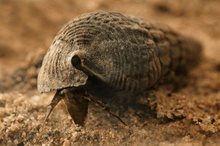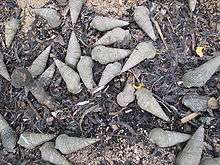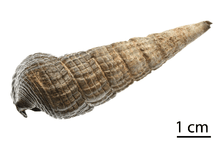Terebralia palustris
Terebralia palustris, common name the giant mangrove whelk, is a species of brackish-water snail, a gastropod mollusk in the family Potamididae.[1] This tropical species which inhabits mangrove environments of the Indo-West Pacific region,[2] has the widest geographic distribution amongst the potamidids [3] extending from eastern Africa to northern Australia. Terebralia palustris is the largest mangrove gastropod, with a maximum shell length of 190 mm recorded from Arnhem Land, Australia.[2]
| Terebralia palustris | |
|---|---|
 | |
| Terebralia palustris | |
 | |
| Terebralia palustris | |
| Scientific classification | |
| Kingdom: | |
| Phylum: | |
| Class: | |
| (unranked): | |
| Superfamily: | |
| Family: | |
| Genus: | |
| Species: | T. palustris |
| Binomial name | |
| Terebralia palustris (Linnaeus, 1767) | |
| Synonyms[1] | |
| |
Distribution
This species has the widest distribution range of any Terebralia species.[2] Its Western Pacific distribution extends south from the Ryukyus to the Philippines and across Borneo, New Guinea and tropical Australia. Eastwards, T. palustris is found as far as Palau as well the New Hebrides and New Caledonia.[2]
The Indian Ocean occurrence of Terebralia palustris includes mangrove habitats throughout Indonesia and regions of South East Asia including India and Ceylon. The species has also been reported from the Andaman Islands, Nicobar, the Maldives, Mauritius, the Seychelles, the Amirantes and Madagascar. Terebralia palustris also occurs along the tropical and subtropical East African coastline including Kenya, Tanzania and Mozambique. The southern global distribution limit for this species is along the eastern subtropical coastline of South Africa. The northward extension of the African distribution is as far as the Red Sea.[2]
Description

Shell
The shell is generally described as elongate, thick, solid and turreted. It comprises as many as 20 flat-sided whorls with the early whorls being sculptured with strong colabral axial ribs. Spiral incised lines appear on the ninth or tenth whorl. These gradually increase in number to three.[2] Growth is determinate for this species and full maturity is indicated by a thickened aperture margin. The size of mature adult snails varies between populations and in some cases maturity has been reported for individuals at only 45 mm total shell length.[2]
Anatomy
The head and foot are typically dark brown while the snout and tips of the cephalic tentacles are black. In females, a ciliated groove on the right side of the foot leads to a large, bulbous white ovipositor which is situated internally near the base of the foot.[2]
The hemocyanin of this species was analyzed by Lieb et al. in 2010.[4] Its mega-hemocyanin have unusually high oxygen affinities.[4]
Ecology
It live in the mud in mangroves.[4] Terebralia palustris is a predominantly mangrove-associated species.[5]
References
- Terebralia palustris (Linnaeus, 1767). Retrieved through: World Register of Marine Species on 17 May 2010.
- Houbrick R. S. (1999) Systematic review and functional morphology of the mangrove snails Terebralia and Telescopium (Potamididae; Prosobranchia). Malacologica 33: 289-338.
- Pape E., Muthumbi A., Kamanu C. P., Vanreusel A. (2008) Size-dependent distribution and feeding habits of Terebralia palustris in mangrove habitats of Gazi Bay, Kenya. Estuarine, Coastal and Shelf Science 76: 797-808.
- Lieb B., Gebauer W., Gatsogiannis C., Depoix F., Hellmann N., Harasewych M. G., Strong E. E. & Markl J. (2010). "Molluscan mega-hemocyanin: an ancient oxygen carrier tuned by a ~550 kDa polypeptide". Frontiers in Zoology 2010, 7:14. doi:10.1186/1742-9994-7-14.
- Zvonareva S., Kantor Yu., Li X. & Britayev T. (2015). "Long-term monitoring of Gastropoda (Mollusca) fauna in planted mangroves in central Vietnam". Zoological Studies 54: 39. doi:10.1186/s40555-015-0120-0.
- Dautzenberg, Ph. (1929). Contribution à l'étude de la faune de Madagascar: Mollusca marina testacea. Faune des colonies françaises, III(fasc. 4). Société d'Editions géographiques, maritimes et coloniales: Paris. 321-636, plates IV-VII pp.
- Steyn, D.G. & Lussi, M. (1998) Marine Shells of South Africa. An Illustrated Collector’s Guide to Beached Shells. Ekogilde Publishers, Hartebeespoort, South Africa, ii + 264 pp. page(s): 38
- Reid, D.G., Dyal, P., Lozouet, P., Glaubrecht, M. & Williams, S.T. (2008) Mudwhelks and mangroves: the evolutionary history of an ecological association (Gastropoda: Potamididae). Molecular Phylogenetics and Evolution 47: 680-699
External links
| Wikimedia Commons has media related to Terebralia palustris. |
- "Terebralia palustris palustris". Gastropods.com. Retrieved 16 January 2019.